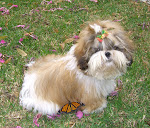 Milkweed is dangerous? Yes, it can be! The milky sap from the Asclepias plant is toxic if ingested (eaten or swallowed). If you have young children, babies, or animals that like to put plants in their mouths, be sure that you keep an eye on them when they are out in the garden, especially if you have Milkweed around.
Milkweed is dangerous? Yes, it can be! The milky sap from the Asclepias plant is toxic if ingested (eaten or swallowed). If you have young children, babies, or animals that like to put plants in their mouths, be sure that you keep an eye on them when they are out in the garden, especially if you have Milkweed around.
Speaking of 'eye,' the milky sap is EXTREMELY dangerous if it gets in your eye. Now, how would it get in your eye, you may wonder…the answer is simple. If you pluck a few leaves or flowers, then rub your face or eyes, then chances are, you may just get some of that sap to drip into your eye!
What will happen if the stuff gets in your eye? First, your eye will burn. Then, it will get red and itch. Soon, the cornea will become inflamed and you will 'lose' your vision. Your vision will literally become blurry and you will see things with a rainbow of colour, like a corona, around them. This is NOT good. In fact, you may even end up with photophobia (sensitivity to light). You will need to get to an ophthalmologist immediately so that prescription drops can be administered. It maya take from a week to two weeks for the pain (yes, it can be quite intense for the first few days!) to lessen and the blurry vision to clear. If you wear contact lenses, guess what. No contacts!
Even if you wear gloves, just remember to keep your hands AWAY from your face.
There's a reason Monarchs and other Milkweed butterflies are poisonous to birds… The Milkweed plant contains a chemical called cardenolides. This chemical is a form of a steroid and is a cardiac arrester (stops the heart). Different species of Milkweed have differing concentrations of this chemical. When a Monarch caterpillar eats the leaves from the Milkweed plant it ingests the cardenolides which then makes it toxic to many vertebrate predators. For example, if a bird ate a Monarch butterfly or caterpillar it would throw up. Research has found that Monarchs that have high levels of cardenolides (from having eaten those Milkweed plants with higher concentrations of the chemical) are much less susceptible to being predated by birds and mice! Isn't this a great way to keep the 'bad guys' away?
The Milkweed plant contains a chemical called cardenolides. This chemical is a form of a steroid and is a cardiac arrester (stops the heart). Different species of Milkweed have differing concentrations of this chemical. When a Monarch caterpillar eats the leaves from the Milkweed plant it ingests the cardenolides which then makes it toxic to many vertebrate predators. For example, if a bird ate a Monarch butterfly or caterpillar it would throw up. Research has found that Monarchs that have high levels of cardenolides (from having eaten those Milkweed plants with higher concentrations of the chemical) are much less susceptible to being predated by birds and mice! Isn't this a great way to keep the 'bad guys' away?
So, let's get back to why you need to watch pets and children around Milkweed. The bitter taste would probably keep dogs from eating it (after one bite), but it is a good idea to have the plants in locations where pets do not have access to them. If the family pet ate enough Milkweed, it could kill them! So, please use care…Babies and young children often put things in their mouths. The bitter taste may make them spit it out but for those children who continue to eat it…it can be bad news!
Special Note: Despite being super careful, this blog editor has had Milkweed latex in the eye THREE TIMES! Things happen, as you know, and when the latex gets in your eye, even if you wash it out immediately, it is not a fun time. So, please, take it from me, BE CAREFUL!
Side note: There is a butterfly called the Viceroy that mimics the Monarch. Why? Because birds and others have already learned that the Monarch 'tastes' badly. The Viceroy, by looking like a Monarch, can safely flutter about without the fear of being eaten! (If eaten, birds wouldn't throw up...because the Viceroy doesn't eat the toxic Milkweed.)
EVERYONE should be careful with Milkweed
Note on Photos & Content
All pictures and content on MyMonarchGuide are the copyright of tdogmom/MonarchFriend. Permission is granted for personal and educational use only.
some of the adorable clip art found on this website is used with the express written permission of D.J. Inkers

